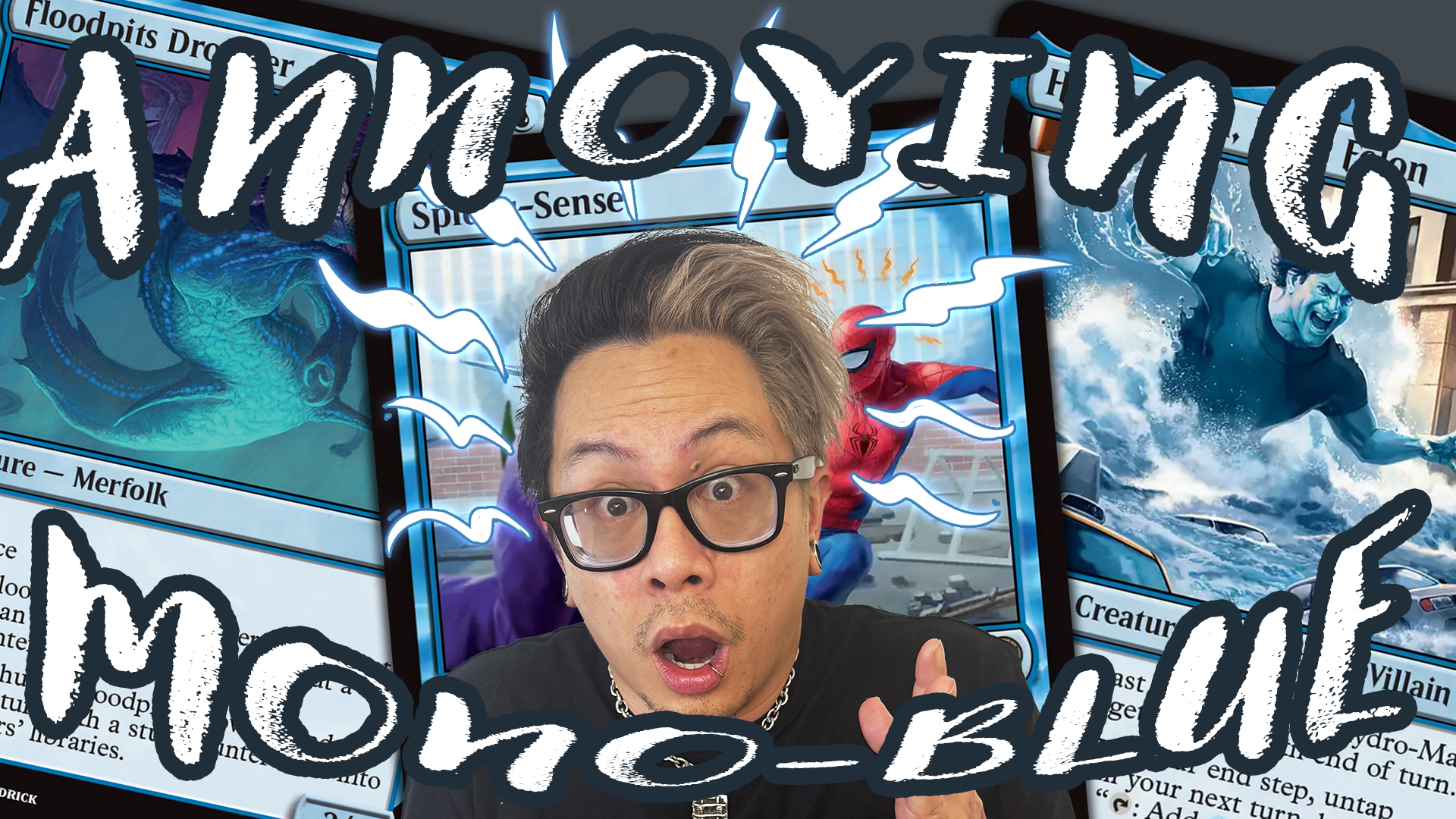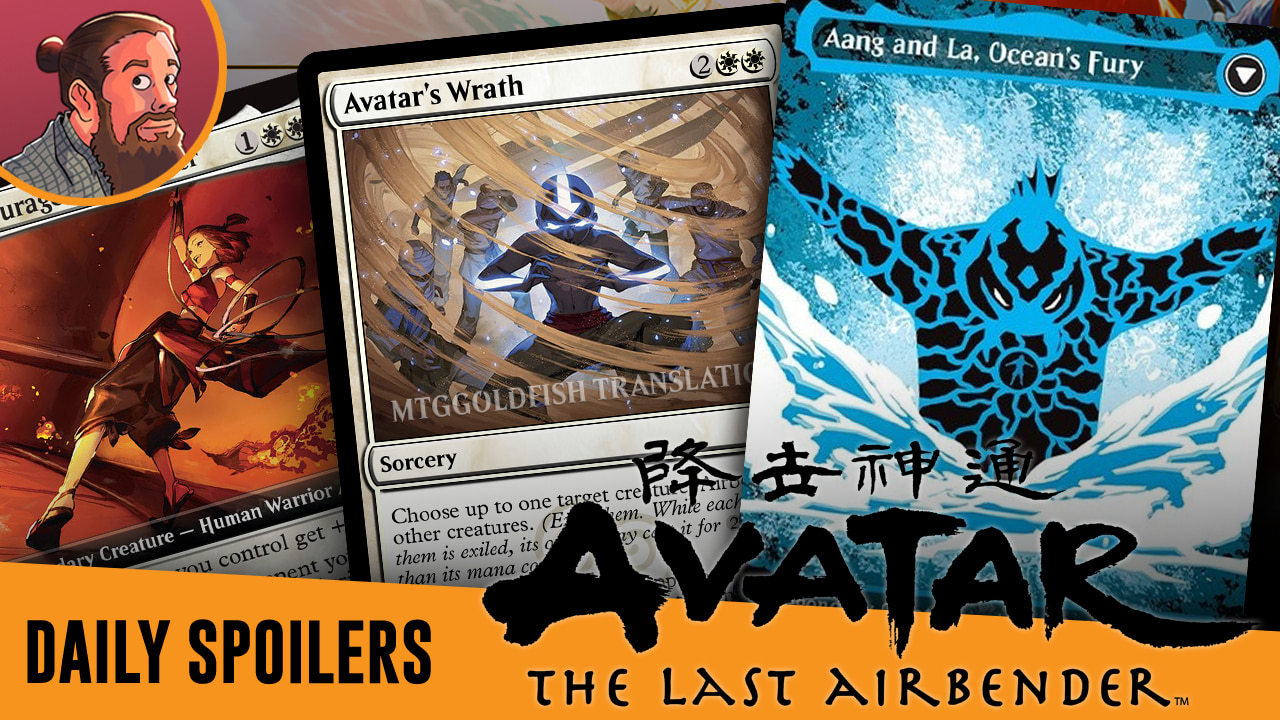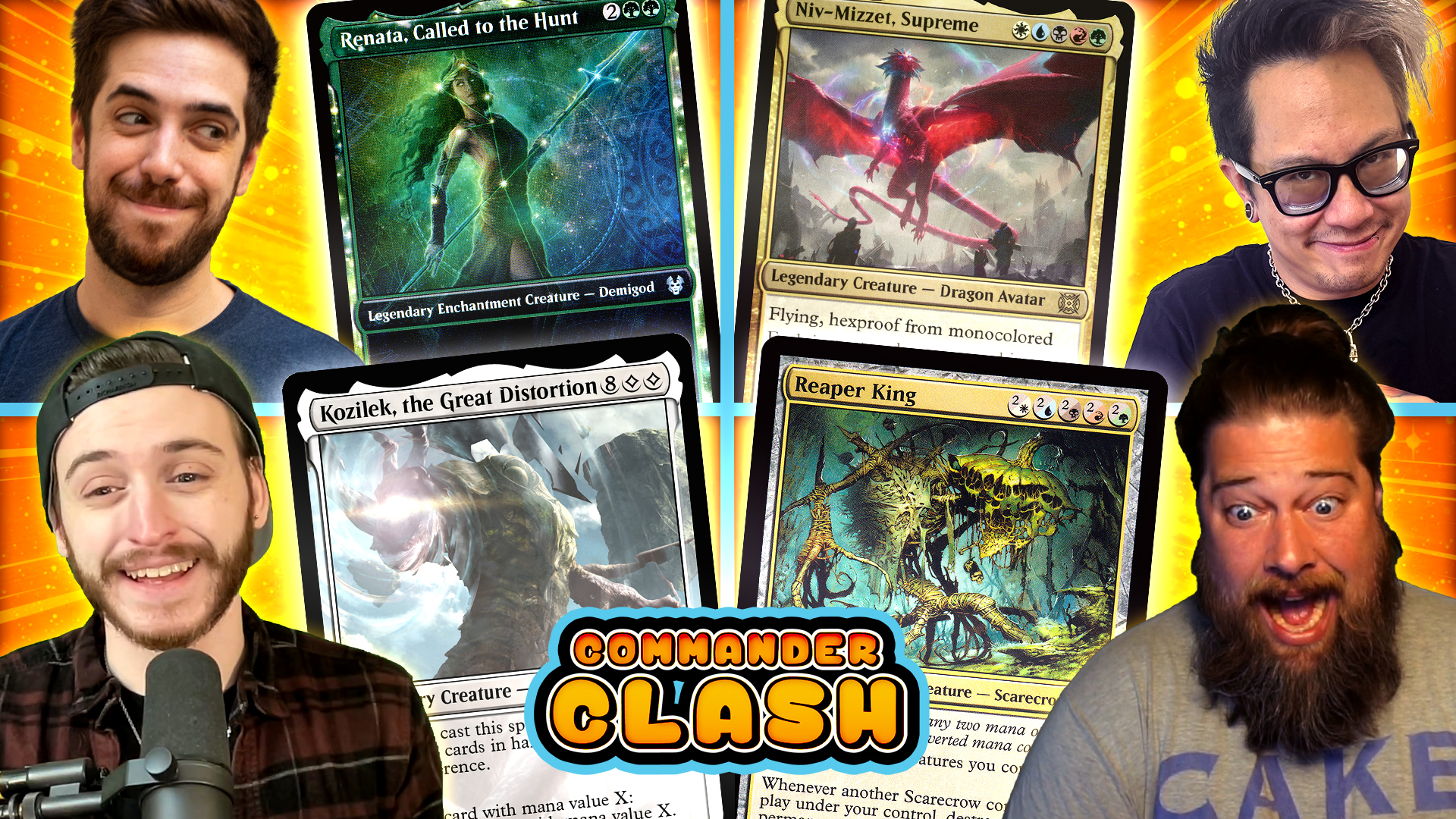The Expected Value of Dragons of Tarkir
One questions that comes up all the time on Twitter, Reddit, and various other forums is "should I buy a box, and if so, what box should I buy?" The common knowledge in the Magic community is that, outside of playing limited, you should never crack sealed product because you are going to lose value; but common knowledge isn't always the best knowledge. It wasn't that long ago that pretty much everyone thought the world was flat, Tarmogoyf was unplayable, and that getting a voluntary lobotomy was the cure for pretty much any mental health problem. Today all of these ideas are laughable (a flat world), if not downright disturbing (Tarmogoyf is bad). So, what about cracking booster boxes?
The short answer is while opening sealed product is often a losing proposition from a value perspective, it isn't always a bad idea. In just the past few years, discounting supplemental products like Commander decks, there have been two sets where if you opened them right after the set release, you could expect to open more value from the box than you paid for the box (Return to Ravnica and Khans of Tarkir). There have also been a few sets where you could expect to (more or less) break even (Gatecrash, Fate Reforged, Theros). And there are a bunch of sets where cracking a box is almost guaranteed to lose you money. Because of this uncertainty, I like to calculate the expected value (EV) of a booster box every time a new set comes out to figure out for myself whether or not buying a box is worthwhile in strictly economic terms.
One more thing before getting into the methodology and the set itself: EV calculations only take into account the cold, hard numbers, and there are many reasons why people buy a box. Some people buy boxes because cracking packs is fun. Others buy boxes to play limited with their friends. For some people, buying a box is a tradition. I'm sure there are a hundred other reasons as well. All of these are fine reasons to purchase a booster box, even a low-EV booster box. While it will not show up in my calculations, there is value in having fun, drafting with friends, and keeping traditions, so don't let a poor EV alone keep you from purchasing a box.
What is Expected Value?
While many of you may be familiar with the concept of expected value, here's a brief refresher. Expected value tells us just how much value we can expect to open from the cards in a booster box. To calculate EV, we first determine the odds of opening a specific card. Next we calculate the value of each card. Then we multiply the odds of opening a card by the card's value, which tells us how much value we expect that card to add to the box. Finally, after we do this for all the cards in the set, we can simply add up the total and determine how much a box is actually worth.
Buylist/Ebay Pricing
Most EV calculations use sell prices, things like TCG-mid or the prices vendors like StarCityGames or ChannelFireball ask for a card. But unfortunately these numbers do not mean much to me for a couple reasons: First, I (and most of you) can't get StarCityGames or TCG-mid prices when we sell our cards (wouldn't that be nice?). Instead we get things like Ebay minus fees and shipping, or buylist prices. As such, in calculating the value of the cards in the set, I'm trying to use the number that I realistically think I can get for the card tomorrow (this is important because new sets tend to decrease in value quickly). For this I use the higher of completed Ebay listings minus 15 percent for fees and shipping, and the best buylist prices (when available).
When it comes to making a profit by opening boxes, timing is everything as prices drop quickly once a new set starts being opened. A set can go from positive EV to negative EV in less than a week, sometimes even overnight. Basically, by opening boxes on release day (or release weekend), we can take advantage of the excitement for the new cards (new demand) and the fact that the freshly-opened cards haven't had a time to reach the market yet (lack of supply).
Methodology Notes
- Commons are considered to be bulk, which I value at $5.00 per thousand. This means that an entire booster box worth of commons adds $1.80 to the expected value of the box.
- Most uncommons are also worthless for the purpose of calculating EV. If you can't expect to sell an uncommon play set for at least $1, it goes into the bulk pile along with the commons.
- Foils are not included. When calculating EV, I consider opening a valuable foil like a bonus lottery ticket you get for free with the purchase of a box. The odds of opening a foil Narset Enlightened is so slim (one in every 3,240 packs) that it's just not worth considering when crunching the numbers. When it happens, it's great, but don't count on it.
- These prices won't be good for long. Remember, the idea is to determine if Dragons of Tarkir is worth opening on release weekend. If you buy a box six weeks from now, don't be mad at me when these prices are wrong, because I can tell you right now they will be wrong, and possibley very wrong. Again, we are trying to take advantage of the hype fueled demand created by the new set (and the subsequent Pro Tour) and the lack of supply.
- Another reminder: You don't actually make a profit until you sell the card. So just cracking boxes on release weekend isn't enough; you need take the next step and actually list the cards on Ebay/TCGPlayer or sell them to a buylist.
- Finally, be aware of variance. If you open enough packs, these numbers will be accurate. But like most aspects of Magic, in small samples, variance can have a huge impact. In theory a booster box could contain zero mythics and all bulk rares, or it could contain a complete set of foil mythics. The more packs you crack the more accurate the EV becomes because you smooth out these outliers.
Dragons of Tarkir: Mythics



| Card | Price | Multiplier | EV Added |
| Clone Legion | $1.36 | 0.3 | $0.40 |
| Deathmist Raptor | $5.52 | 0.3 | $1.66 |
| Descent of the Dragons | $2.55 | 0.3 | $0.77 |
| Dragon Whisperer | $4.76 | 0.3 | $1.43 |
| Dragonlord Atarka | $4.25 | 0.3 | $1.28 |
| Dragonlord Dromoka | $5.78 | 0.3 | $1.73 |
| Dragonlord Kolaghan | $4.30 | 0.3 | $1.02 |
| Dragonlord Ojutai | $4.25 | 0.3 | $1.26 |
| Dragonlord Silumgar | $4.93 | 0.3 | $1.48 |
| Narset Transcendant | $34.00 | 0.3 | $10.20 |
| Ojutai Exemplars | $5.36 | 0.3 | $1.61 |
| Risen Executioner | $1.70 | 0.3 | $0.51 |
| Sarkhan Unbroken | $17.85 | 0.3 | $5.34 |
| Shaman of Forgotten Ways | $4.68 | 0.3 | $1.40 |
| Shorecrasher Elemental | $5.10 | 0.3 | $1.53 |
| Totals: | $106.39 | n/a | $31.98 |
With the mythics we are off to an inauspicious start to our analysis. Adding only $31.98 is comparatively poor, as is the average mythic price of $7.09. For context, the mythics in Fate Reforged added $42.62 to the box value and had an average value of $9.47.
These numbers are downright shocking when you consider that Dragons of Tarkir doesn't have an expensive rare land cycle eating up value. Consider Avacyn Restored, probably the best comparison to DTK: Both sets lack an expensive land cycle, both sets are filled with high-CMC mythics of a popular casual tribe, and both are large third sets. You would think that, given all these similarities, prices during pre-orders would be similar, right? Actually, this couldn't be further from the truth. When AVR released the average value of a mythic from the set was $11.97, nearly five whole dollars more than DTK. Along the same lines, the mythics from AVR added $53.88 of expected value to a box — over $20 more than the DTK mythics add to their box.
When a set is lacking in expensive rares, you expect to see the mythics pick up the slack and maintain higher prices (see: Voice of Resurgence), but for some reason this does not seem to be the case with Dragons of Tarkir. You'll see what I mean as we break down the rares.
Rares of Dragons of Tarkir


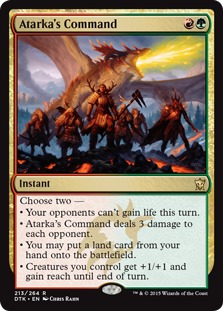
| Card | Price | Multiplier | EV Added |
| Anafenza, Kin-Tree Spirit | $1.94 | 0.6 | $1.17 |
| Arashin Foremost | $1.29 | 0.6 | $0.78 |
| Assault Formation | $1.62 | 0.6 | $0.97 |
| Atarka's Command | $3.83 | 0.6 | $2.30 |
| Collected Company | $3.83 | 0.6 | $2.30 |
| Commune With Lava | $1.29 | 0.6 | $0.78 |
| Damnable Pact | $1.29 | 0.6 | $0.78 |
| Den Protector | $0.85 | 0.6 | $0.51 |
| Dragon Tempest | $1.87 | 0.6 | $1.12 |
| Dromoka's Command | $2.55 | 0.6 | $1.53 |
| Haven of the Spirit Dragon | $2.55 | 0.6 | $1.53 |
| Icefall Regent | $0.85 | 0.6 | $0.51 |
| Ire Shaman | $0.85 | 0.6 | $0.51 |
| Kolaghan's Command | $1.70 | 0.6 | $1.02 |
| Mirror Mockery | $0.85 | 0.6 | $0.51 |
| Myth Realized | $3.40 | 0.6 | $2.04 |
| Ojutai's Command | $3.40 | 0.6 | $2.04 |
| Radiant Purge | $0.85 | 0.6 | $0.51 |
| Secure the Wastes | $3.19 | 0.6 | $1.91 |
| Sidisi, Undead Vizier | $2.80 | 0.6 | $1.68 |
| Silumgar's Command | $1.06 | 0.6 | $0.64 |
| Stratus Dancer | $1.28 | 0.6 | $0.77 |
| Surrak, the Hunt Caller | $1.53 | 0.6 | $0.92 |
| Thunderbreak Regent | $4.25 | 0.6 | $2.55 |
| Zurgo, Bellringer | $1.53 | 0.6 | $0.29 |
| Semi-Bulk (10 cards) | $0.25 | 0.6*10 | $1.50 |
| Bulk (13 cards) | $0.10 | 0.6*13 | $0.78 |
| Totals | $54.22 | n/a | $32.53 |
As far as the DTK rares, their value is acceptable considering the lack of a land cycle, but still unexciting. It's slightly below Fate Reforged if you count the basic-land-slot fetches, and far below a set with a true land cycle like Khans of Tarkir. In fact, the $1.02 average value of a DTK rare is less than half the KTK average of $2.40. KTK fetches, in and of themselves, added more to the value of a KTK box than all of the rares in DTK add to their box.
The other surprising things is just how many of the "chase" rares from DTK are in Intro Packs and the Event Deck. Thunderbreak Regent and Surrak, the Hunt Caller joins Savage Knuckleblade, plus a couple Wild Slashes and Rousts as the best cards in the Landslide Charge Event Deck, while Myth Realized and Secure the Wastes are split between two of the DTK Intro Packs. This probably doesn't matter much for our immediate EV calculation, but over the long term, supply on these rares will be higher than the others in the set, which could reduce their price, or at very least, limit their potential for growth.
Uncommons and Bulk
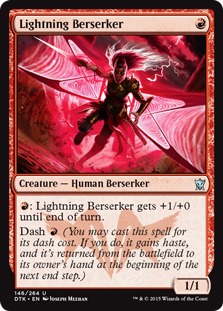


Looking over the uncommons from the set, there does not appear to be any Stoke the Flames or Lingering Souls type cards. Instead we have a handful of uncommons that might fetch $2 per play set. Included in this very red list are Blood-Chin Rager, Draconic Roar, Lightning Berserker, Roast, and Sarkhan's Triumph. There are also a bunch of uncommons that you might be able to sell for $1 per set, including the multi-color dragon cycle and some of the Encase in Ice hate cycle. When you consider that, on average, you'll open 1.35 of each uncommon from a box, the five most valuable uncommons add about $3.38 to the value of the box. If we figure there are another 8 uncommons in the $1/set range, this adds another $2.70. The rest of the cards in the box (basic lands, commons, and the left-over uncommons) are bulk and at $5/thousand, add another $2.50 to the box EV.
Adding It Up
| Rarity | Average Price | Number | Value Added |
| Mythic | $7.09 | 15 | $31.98 |
| Rares | $1.02 | 53 | $32.53 |
| Best Uncommons | $0.50 | 5 | $3.38 |
| So-So Uncommons | $0.25 | 8 | $2.70 |
| Bulk C/U/Lands | $5/Thousand | 500 | $2.50 |
| Total Value | $73.19 |
There you have it: if you crack a box of Dragons of Tarkir, a box that will cost somewhere in the neighborhood of $100, you can expect to open $73.19. This means, on average, you'll lose nearly $27 for every box you open. To break even, you pretty much have to open a Narset Transcendant, which unfortunately will only happen once every 3.33 boxes. Even vendors who get boxes for around $70 wholesale can't really make a profit at these prices considering you need someone to open the box, sort the cards, and list them for sale. So if you are thinking about cracking a box for immediate value, please don't. You will have to run incredibly well just to break even. How does this compare to the other sets in the Khans of Tarkir block?
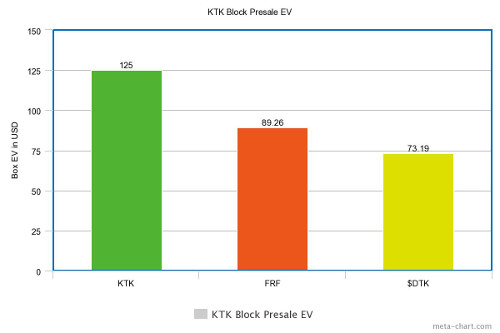
KTK maintained a positive EV for several weeks after it was released in September, largely on the value of fetchlands, but aided by breakout cards from the Pro Tour like Siege Rhino, Dig Through Time, Sarkhan Dragonspeaker, and Mantis Rider. FRF started out close to the break-even point and briefly hit positive territory when Ugin, the Spirit Dragon and a handful of rares spiked the weekend after the set released.
DTK, on the other hand, is so far negative that even Pro Tour related spikes are unlikely to push a box into positive territory. It's just that bad. Let's see what this means for the future of DTK prices 6-8 months down the line. Let's look at Dragons of Tarkir pre-sales EV compared to other Standard legal sets that are already at peak supply.
Dragons of Tarkir vs Peak Supply
To make a fair comparison between Dragons of Tarkir and other sets a peak supply, we first need to find out how much an average set decreases in value in the six or eight months after its release. For this, we can use the total set prices found here on MTGGoldfish and simply do the math. 
As this graph shows, without fail, sets always decrease in value as they are opened and redeemed (this much is basic economics). The nice thing about this data is we can quantify just how much the average set drops. The decrease ranges from a low of 21.5 percent for Khans of Tarkir (which could still fall further) to a high of of 48.2 percent for Born of Gods. If we average everything up, you'll see that the typical set loses 35.4 percent of its value in the first six or eight months after its release.
Our next step is to find the EV of other sets. Since this would be a little too much work for me to do card-by-card, for this we will use the set EV's on Dawnglare. Since Dawnglare's EV calculations use tcg-mid pricing, they are typically higher than mine across the board. While I don't think they provide as fair a representation of how much cash you can get for your cards, they will work just fine for the sake of comparison. So how will DTK look in the future with an average deduction of 35.4 percent (our estimate of the "peak supply" price)? Let's take a peak.
If DTK decreases in value like other sets, it will have the lowest EV of any set since the historically bad Dragon's Maze, which had an EV in the mid-$40 range. In fact, maybe the most shocking realization from doing this research is, as of right now, you can expect to open more value from a box of Magic 2015 — a set which will rotate in a few short months — than from Dragons of Tarkir during its presale period (a time when the set's price and box EV is typically at its peak).
The Other Side
There is another possibility: maybe Dragons of Tarkir is simply underrated and under-priced at the moment (as odd and backwards as that sounds). While the community reaction to the set has been mixed, it hasn't been wholly mocked like Dragon's Maze. Plus, there are a lot of cards that have potential to be powerful, even if their applications are not as obvious as above-the-curve beaters like Siege Rhino or eternal staples like Dig Through Time. I'm not willing to say that DTK can maintain its current price as supply increases over the next few months, but it does seem possible and even likely that instead of dropping 35 percent, it drops something like 15 percent, still putting it towards the low-end, but more within the typical range.
Since the set is so low in EV, it's not impossible that DTK gives us another Voice of Resurgence, a chase mythic that eats up a ton of EV just because the rest of the cards in the set are so inexpensive. There is also significantly more room for a rare to spike to the $15 range (although I can't see any obvious candidates). If we take things one step further, I can see an argument that being of such low value is actually a good thing in the long-term.
As I mentioned earlier, right now the EV of DTK is so low that when you consider all the costs, even people who can get boxes at wholesale (around $70) can't make a profit opening them. Sure, local gaming stores and big vendors will still crack some amount of boxes just because they need the cards for inventory and to fulfill presales, but it seems likely that they will crack significantly less than normal. This could mean lower supply in the long term, although whether or not this is overcome by casual players who don't care about EV and just want to open some sweet Elder Dragons, remains to be seen.
Maybe even more important is the short cycle of DTK. In a little over a month, the Magic community will have moved onto spoilers for the most hyped release of the year: Modern Masters 2015. Not only will the focus be shifted away from DTK, but some people will probably skip buying a DTK box altogether and save their money for the much more exciting (and likely better EV) Modern Masters 2015. This could limit the supply Dragons of Tarkir even more.
On the other hand, the set is stuffed full of casual hits. Dragons are super popular, as are zombies, and even morph has its following. We get dragon tutors, uncommons that reduce the casting cost of popular casual mechanics, and more dragons. Even before discussing the potential supply issues, there are ~50 cards in the set that have potential to grow from casual demand alone. If very few people open the set, you have the recipe for some big casual gainers in a couple of years. While there will be more DTK cards in circulation than pre-boom sets, there will likely be less than for most sets over the past five years, even including other traditionally low-supply third sets. As a result, I'll be looking looking specifically for foil uncommons and basically any of the rare or mythic dragons (or cards that work well with dragons) if they drop to or near bulk rates.
Conclusion
Anyway, that's all for today. What do you make of these numbers? Do you see any candidates for the next Voice of Resurgence or Snapcaster Mage? Is Dragons of Tarkir going to lose as much value as a typical set? What cards (if any) are you buying now? What cards (if any) are you going to buy two or three years from now? Let me know in the comments, or you can reach me on Twitter @SaffronOlive.




